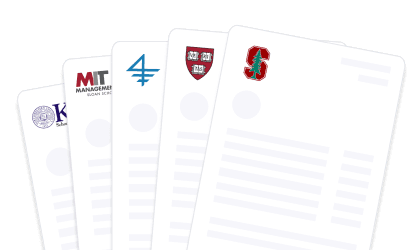Addressing the Most Significant Challenge Society Faces Today: Stanford Essay Insights How to Nail the Stanford University College Essay Prompts
Discover expert insights on how to tackle the most significant challenge society faces today in your Stanford University college essay prompts.
Posted April 3, 2025

Table of Contents
As an aspiring Stanford applicant, you're aware that the college essay prompts can make or break your application. But with so many options to choose from, it can be overwhelming to pick the right one. In this article, we'll break down the purpose of the Stanford University college essay prompts and provide valuable tips on how to nail them and secure your admission to one of the best universities in the world.
The Importance of Choosing the Right Stanford Essay Prompt
The first step in successfully completing your Stanford essay is choosing the right prompt. The essay prompts are designed to give you the opportunity to showcase your personality, values, experiences, and achievements. Your goal is to choose the prompt that aligns with your approach to life and lets you showcase who you are.
It is important to note that each prompt has its own unique focus and requires a different approach. For example, the prompt "What matters to you, and why?" is more open-ended and allows for a wide range of topics, while the prompt "Describe an experience that has fundamentally changed the way you see the world" requires a specific event or experience to be discussed. Therefore, it is crucial to carefully read and understand each prompt before making a decision.
Understanding the Purpose of Stanford University's College Essay Prompts
The Stanford University College essay prompts are designed to evoke self-reflection, intentionality, and authenticity from the applicants. The admissions board is looking for students who are self-aware, reflective, and passionate about their interests. It's your chance to showcase who you are beyond your academic transcripts and achievements.
One of the key reasons why Stanford University uses essay prompts is to gain a deeper understanding of the applicant's personality and character. The admissions board wants to know what motivates you, what challenges you have faced, and how you have grown as a person. By sharing your personal experiences and insights, you can demonstrate your resilience, creativity, and leadership potential.
Another important aspect of the Stanford University College essay prompts is that they encourage applicants to think critically about their goals and aspirations. The prompts are designed to help you articulate your vision for the future and explain how your academic and extracurricular experiences have prepared you for success. By demonstrating your passion and commitment to your chosen field, you can convince the admissions board that you are a strong candidate for admission to Stanford University.
Tips for Brainstorming and Outlining Your Stanford Essay
Before jumping into the writing process, take some time to brainstorm your ideas and outline your essay's structure. Think about your significant accomplishments, values, and passions. Ask yourself what you want to convey to the admissions board and how you want to present your story. Make sure to create an outline that includes an introduction, body, and conclusion.
When brainstorming, don't be afraid to think outside the box. Consider unique experiences or perspectives that have shaped who you are today. Also, try to avoid cliches and overused topics, such as winning a sports game or volunteering at a soup kitchen. Instead, focus on what makes you stand out and what sets you apart from other applicants.
Once you have a solid outline, don't be afraid to revise and refine it. Your essay should flow smoothly and have a clear message. Make sure to use specific examples and anecdotes to support your points. And most importantly, be authentic and true to yourself. Admissions officers want to get to know the real you, not a version of yourself that you think they want to see.
Crafting a Compelling Introduction for Your Stanford Essay
Your introduction is the first impression the admissions board will have of your essay, and it sets the tone for the rest of your paper. Your goal is to capture their attention with a compelling hook that sets your essay apart from the rest. Begin with a quote, a question, or an anecdote to pique their interest.
It's important to remember that your introduction should also provide a clear and concise overview of what your essay will cover. This will help the reader understand the purpose and scope of your paper. Additionally, make sure to avoid cliches and generic statements that could apply to any essay. Instead, focus on highlighting your unique perspective and voice. By crafting a strong introduction, you'll set yourself up for success and leave a lasting impression on the admissions board.
Showcasing Your Unique Perspective in the Body of Your Stanford Essay
The body of your essay is where you showcase your unique perspective, experiences, and values. Make sure to incorporate concrete examples that illustrate your approach to life and how it has shaped your worldview. The admissions board is looking for students who have a unique outlook, and it's your chance to showcase who you are.
One effective way to showcase your unique perspective is to discuss a challenge or obstacle you have faced and how you overcame it. This can demonstrate your resilience and problem-solving skills, as well as provide insight into your character.
Additionally, consider discussing any extracurricular activities or hobbies that have had a significant impact on your life. Whether it's playing a sport, volunteering, or pursuing a creative passion, these experiences can provide valuable insight into your personality and values.
Highlighting Your Achievements and Accomplishments in Your Stanford Essay
Your Stanford essay is an opportunity to highlight your achievements and accomplishments. But be careful not to brag or come off as arrogant. Instead, illustrate your achievements and how they have impacted your growth and development. Focus on how your accomplishments have contributed to your personality, values, and aspirations.
One effective way to showcase your achievements is to provide specific examples and anecdotes. For instance, if you received an award for your leadership skills, describe a time when you demonstrated those skills and how it impacted your team or community. Additionally, don't forget to mention any challenges or obstacles you faced along the way and how you overcame them. This will demonstrate your resilience and determination, which are valuable qualities in any applicant.
Demonstrating Your Passion and Drive in Your Stanford Essay
The admissions board is looking for students who have unique passions and drive, so make sure to showcase yours in your essay. Share your interests and how they have impacted your personal and academic growth. Be authentic and avoid writing what you think the board wants to hear.
One way to demonstrate your passion and drive is to discuss any challenges you have faced and how you overcame them. This can show the admissions board that you are resilient and determined. Additionally, you can highlight any leadership roles you have taken on, whether it be in school clubs or community organizations. This can showcase your ability to take initiative and make a positive impact.
It's important to remember that your essay should not only focus on your achievements, but also on your values and beliefs. Share your perspective on important issues and how you hope to make a difference in the world. This can demonstrate your passion for creating positive change and your commitment to making a difference in your community and beyond.
Avoiding Common Pitfalls and Mistakes in Writing Your Stanford Essay
Students often make common mistakes when writing their essays. Avoid using clichés, using overly complex vocabulary, or straying away from the prompt. Make sure to edit and proofread your essay for grammar errors and structural coherence.
Utilizing Strong Examples and Evidence to Support Your Claims in Your Stanford Essay
Make sure to use strong examples and evidence to support your claims in your essay. Use specific anecdotes, figures, and data to illustrate your arguments. Avoid overly general statements and unsubstantiated claims.
Polishing and Proofreading Your Stanford Essay for Clarity and Coherence
Ensure that your essay is polished and proofread for clarity and coherence. Have someone else proofread for you to ensure you catch any errors and inconsistencies. You want your essay to be as clear and succinct as possible.
Overcoming Writer's Block and Staying Motivated When Writing Your Stanford Essay
Writer's block and lack of motivation can be detrimental to your essay writing process. Make sure to take breaks and stay motivated. Work with a writing coach, mentor, or friend to help you overcome any challenges or struggles.
Getting Feedback on Your Stanford Essay from Peers, Mentors, or Writing Professionals
Getting feedback on your Stanford essay from a different perspective can be helpful in perfecting your essay. Take feedback seriously and try to implement suggestions that make sense. Make sure to work with qualified professionals who can help you make strong improvements.
Understanding the Role of the Stanford College Essay in the Admissions Process
The Stanford College essay serves as a critical component of the admissions process. It's a chance to showcase your personality, values, and achievements and is a way for the admissions board to distinguish between all the applicants.
Conclusion: Final Thoughts on How to Successfully Nail the Stanford University College Essay Prompts
In conclusion, nailing the Stanford University College essay prompts is a crucial step in gaining admission to one of the top universities in the world. Remember to choose the prompt that aligns with your values and personality, craft a compelling introduction, use concrete examples and evidence to support your claims, avoid common pitfalls, and ensure your essay is clear and coherent. Good luck on your application journey!



















